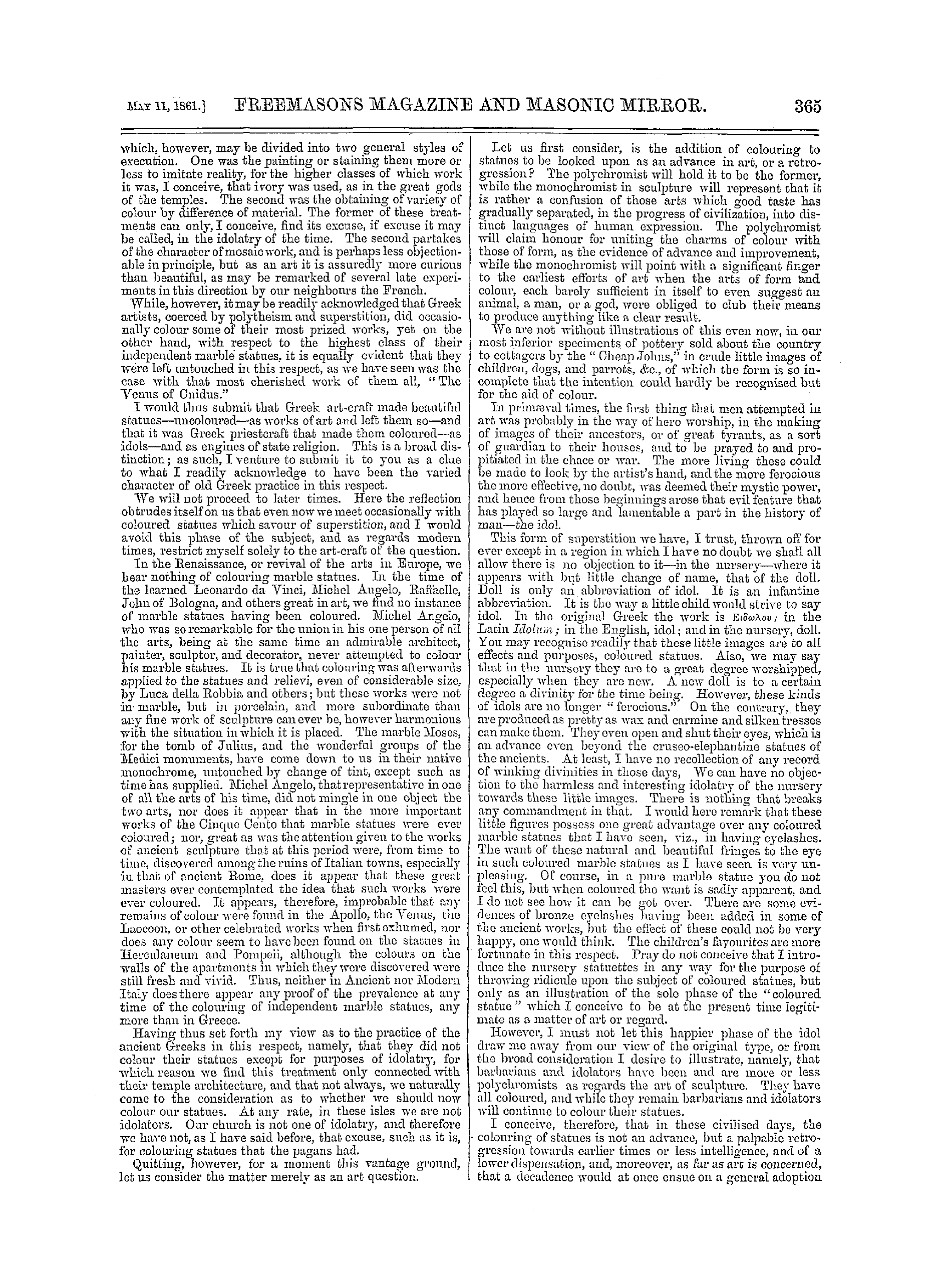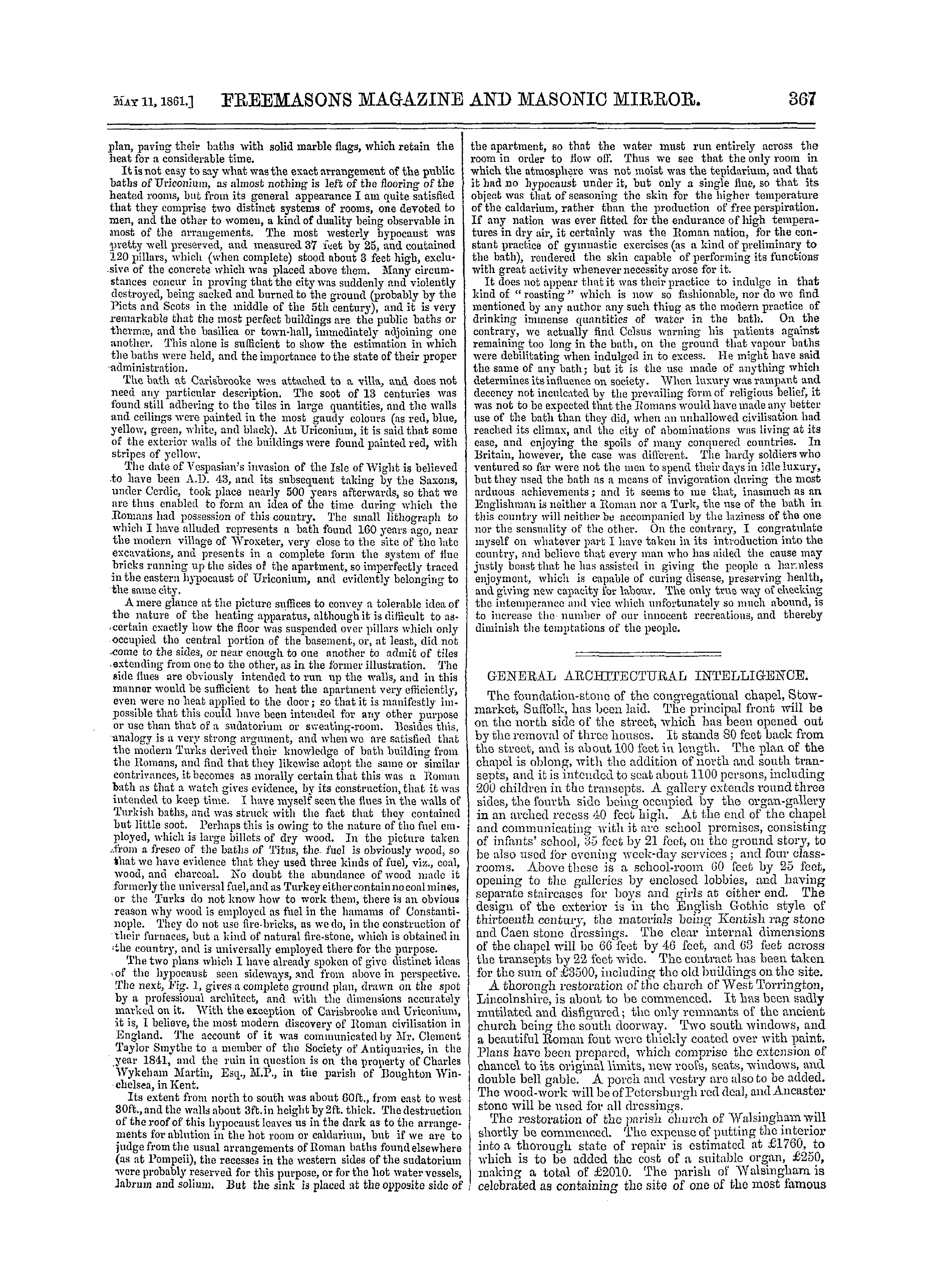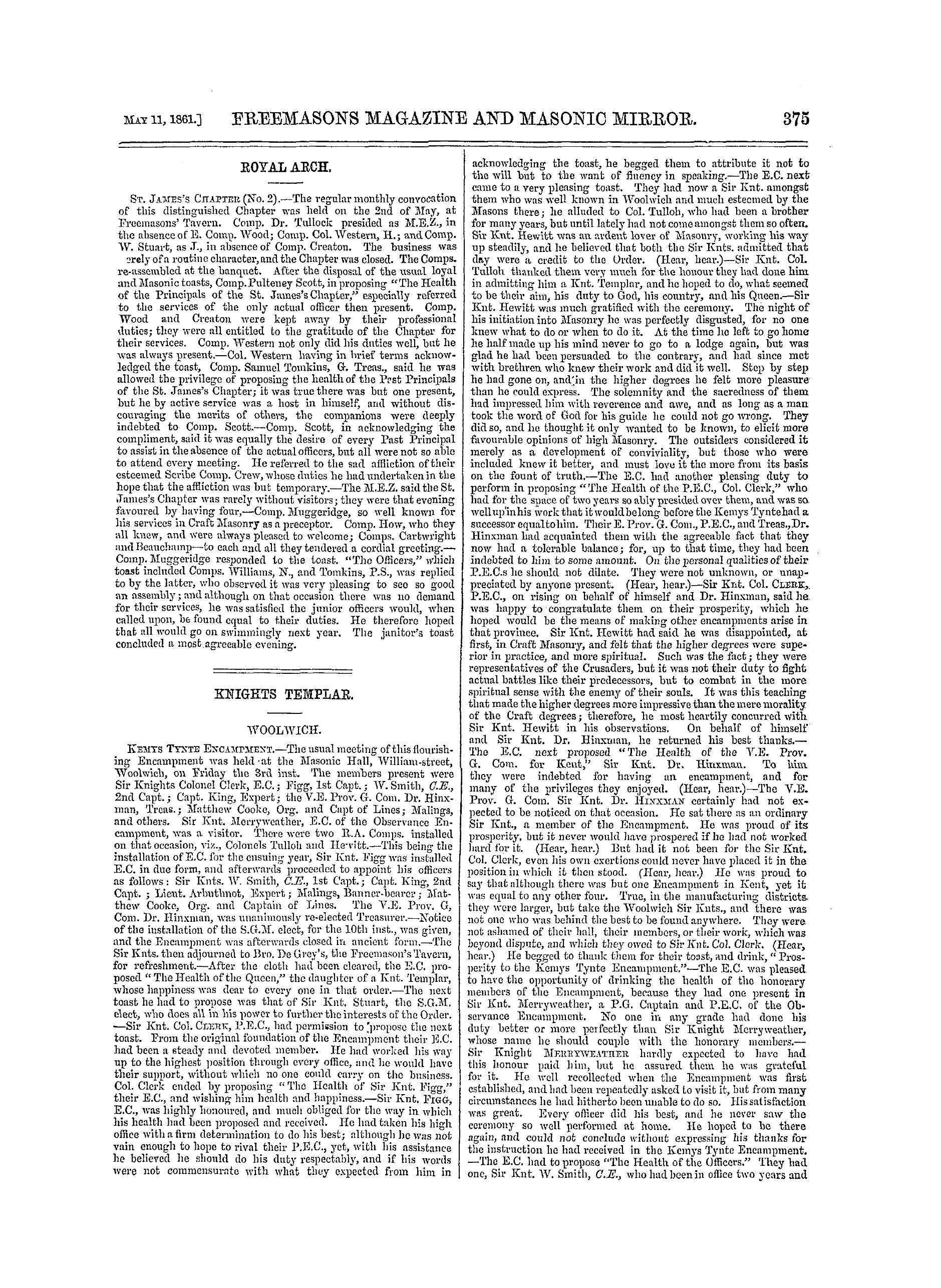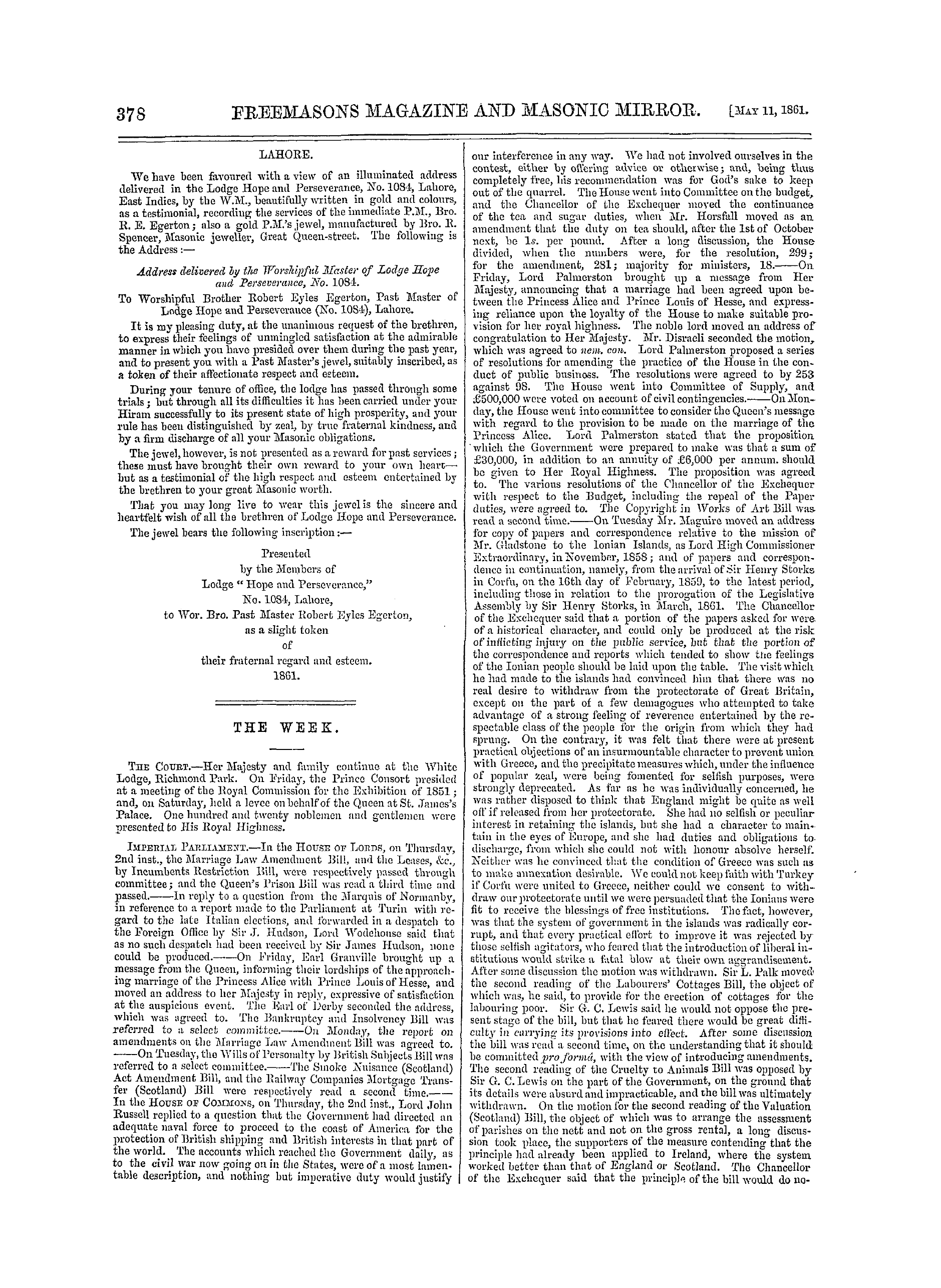-
Articles/Ads
Article MASONIC NOTES AND QUERIES. ← Page 3 of 3 Article NOTES ON LITERATURE, SCIENCE, AND ART. Page 1 of 2 →
Note: This text has been automatically extracted via Optical Character Recognition (OCR) software.
Masonic Notes And Queries.
HELE , CONCEAL , AND NEVER REVEAL . Are not the words " Hele , Conceal , and never Eeveal , " synonymous ? If so , why are they used ?—PHILOLOGICUS—[ They are of the earliest kind of rhyme known amongst primitive people , and called Head rhymes . For a very interesting disquisition on this subject , see our gifted Bro .
Dr . Hyde Clarke ' s Grammar for the English Tongue , p . 145 , et scq . ] THE TRIPLE CROSS OF SALEM . AVhere shall I find any account of the Triple Cross of Salem ; what are its symbolical peculiarities , and why it takes its name from Salem in particular!—J A . CAN A KNIGHT TE 3 IPLAR BE A KNIGHT OE MALTA ?
I am desirous of knowing if a Knt . Templar can , consistently , be a Knt . of Malta ?—Ex . Ex . —[ See Ilistoira des Secies lieligieuses , par . M . Gregoire , ancien civeque do Blois , Paris , 1828 , in which it is stated , — "Le primat actuel est vie-Cesarini , commandenr convontuel do l ' ordre de Malte . Les ci-devant Chevaliers de Malte qui , depuis trente ans , s ' efforcent de ressusciter leur ordre , avaient fait , dit-on , des avances pour s ' uuir aux Tcmpliers , et par ce moyen fortifier leurs reclamations . " ]
Notes On Literature, Science, And Art.
NOTES ON LITERATURE , SCIENCE , AND ART .
In noticing the present exhibition of the JN " ew Society of Painters in AVater Colours , the fine arts critic of the Athenamm remarks : — "Close to the floor will be found a charming study from a lovely phase of nature , by Mr . T . Satellite , An Evening Shy atBedcar ( 35 ) , the beach just at sun setting , wave upon wave creeping up the gently sloping shore , and reflecting in each sheeny surface the glorious
hues of the sk y above—deep violet ivhere the hollow tells of the horizon , and verging through red , scarlet , orange , and yellow , to where the zenith is reproduced on the levels that swim forward ; just in the breaking wave a fishing-craft comes ashore , the method of doing which is perfect in action . Bej-ond are the fresh waves crisply breaking ivith little petulant crests , and the sun purple of the evening slowly sweeping up , and merging into the sky itself with coming darkness . This is the most striking of Mr . Sutcliffo's studies , but we must commend them all , notwithstanding a certain sootiness in more than one , to our readers . "
A public dinner , to celebrate the inaugiiration " of the Havelock statue , is to be held at Sunderland , on AVhit Tuesday ( May 21 st ) , when Samuel Alcock , Esq ., the mayor , will preside . Mr . Hepworth Dixon has failed to convince the writers of the Edinburgh Bevicw of the purity of the groat Lord Bacon ; as the following extract will show : — " AVhen the main idea of a work is
unsound , it is little to the purpose that here and there it contains some new and original matter , and now and then some acute observations ; but , even in these subordinate respects , Mr . Dixon can claim but little commendation . AVhile we have no doubt that his theory is false , and that all he has said will not shake in the least the general opinion of Bacon ' s character ; and ivhile he has used all the artifices of an advocate in embellishing facts that tell
on bis side , and making enormous omissions and misstatements , we must also add that his original researches have not been fruitful of much new matter , on points at least of paramount importance . As for the manner , design , and style of this book , they appear to us to be in the worst possible state . A biography should be a portrait executed with manliness , simplicity , and truth , not a display of spasmodic rhetoric , tawdry ornament , and false effect ; ancl wo
regret to have so soon to notice another distressing example of those extravagances and deformities of style with which Mr . Carlyle has infected the English language . " And again : — " Mr . Dixon appears to us not to have materially altered the aspect of the case ; and certainly the declamatory vehemence and rhetorical artifices which he employs are altogether out of place . AVe still await with interest the more mature publication of the biographical volumes with
which Mr . Speckling has promised to complete his magnificent edition of the works of Bacon ; but we do not conceive that any fresh manipulation of historical evidence can change the moral conviction arising from a candid survey of Bacon's life . " Mr . G . II . R . Young is engaged in modelling a life-size bust of Sir John Fife , the eminent medical practitioner of Newcastle-upon-Tyne . The bust , which is to be afterwards sculptured in marble ,
is said to be a goocl likeness ; but , with singular bad taste , Sir John is represented in his uniform as Lieutenant Colonel of the Newcastle Rifles , —just as though he was some great warrior ,
instead of a scientific man , who has earned for himself a worldwide reputation by his skill in the healing art , and especially for his operations for diseases of the eyes . Mr . Horace Greeley , the able editor of the New York Tribune , commenting on the close of his twenty years' connection with that journalsays : — " The Tribune enters this day upon the twenty-first
, year of its existence , havingfirst been issued on the 10 th of April , 1841 . . . . The very few personal friends or political sympathisers who welcomed the first issue of this paper on that sour , sleety morning , have grown into a goodly company—the aggregate number of our regular patrons being hardly less than three hundred thousand , while our habitual readers must considerably exceed one , million . The current expences of the first week of our enterprise were 325
dollars ; the receipts , 92 dollars . Now , our expences are some 10 , 000 dollars per week , and our receipts—in spite of the hard times—rather exceed that sum . For telegraphing alone—an expense totally unknown to journalism twenty years ago—we pay more weekly than the entire cost of publishing the Tribune in 18-11 ; while the intellectual resources of a leading journal , for which 100 dollars per week was ' an ample provision twenty years ago , now costs us more than 1000 dollars per week .
Captain Mayne JReicUm his recent work , The Wild Huntress , thus pithily deseribesasquattcr'scIearingintheimmeiiseTennesseanforest — "Thesquatter ' s clearing is a mere vistal opening in the woods from which only tho underwood has been removed . The more slender saplings have been cut down or rooted up ; the tangle of the parasitical plants has been torn from the trees , the cane brake has been firedand the brushcollected in heapshas melted away
, , , upon the blazing pile ; only a few stumps of inferior thickness give evidence that some little labour has been performed by the axe . Even thus , the clearing is a mere patch , scarcely two acres in extent ; and the rude rail fence that zigzags round it attests that the owner is satisfied with the dimensions of his agricultural domain . There are no recent marks of the axe , not even the ' girdling' of a- treenothing to show that another rood is required . The squatter is
essentially a hunter , ancl hates the sight of an extensive clearing as he would the labour of making one . The virgin forest is his domain , and he is not the man to rob it of its primeval charms . The sound of the lumberer's axe , cheerful to the lonely traveller , has no music for his ear ; it is to him a note of evil augury , a knell of dread import ; it is not often that he hears it—he , dwells beyond the circle of its echoes . His nearest neihbour ; a squatter like himself
g , lives at least a mile off , and the most proximate ' settlement' is six times that distance from the spot he has chosen for his cabin . The smoke of his chimney mingles with that of no other ; its tall column ascends to heaven solitary as the squatter himself . " The Rev . Dr . Aliughan , in the second volume of his Bevolutimis
m English History , just issued , gives the following sketch of the character of Catherine of Arragon : — "The character of this ill-fated princess ' contrasted too strongly with that of her second husband to afford any large promise of happiness . In the love of literature , the king and queen possessed a taste in common ; and there were times when Henry seemed to regard the piety of Catherine with a feeling of reverence . Her religionhoweverwas of a kind that would have qualified her for
, , the head of a convent , hotter than for the head of a court . She had entered the third order of St . Francis , and always wore the habit of that order under her queenly vestments . Saturday ancl Sunday were her fast-days , ancl on the vigils of the Ali-gin she took only bread and water . In the middle of the night she rose to repeat her prayers , and by five in the morning she left her chamber dressed for the clay . Six hours every morning were spent in church
, her knees bent for long intervals on the bare floor . Twice a week all her feelings and thoughts were unbosomed to hev confessor . AVhen dinner was over , two hours were given to reading the lives of the saints . On these occasions her maids were with her , to be edified by her reading , her counsel , and her example . AVliat time remained was occupied with reading or prayer , until the hour for supper , which was always a simple repast . So the day ended .
Henry was a man of religious conviction and feeling ; but a wide gulph separated between the queen ' s temperament and his own on that subject . In many other respects the divergence between them was great . " A number of finished works of the late Francis Danhy , Esq ., A . R . A ., are about to be offered by public auction . The collection includes four important pictures exhibited at the Royal Academy ,
about a score of smaller pictures , several sketches in oil , watercolour drawings from nature , and pen-and-ink sketches ; many of them being the first thoughts for the pictures painted by Mr . Dauby , and others for works contemplated but never Jaccomplished .
Note: This text has been automatically extracted via Optical Character Recognition (OCR) software.
Masonic Notes And Queries.
HELE , CONCEAL , AND NEVER REVEAL . Are not the words " Hele , Conceal , and never Eeveal , " synonymous ? If so , why are they used ?—PHILOLOGICUS—[ They are of the earliest kind of rhyme known amongst primitive people , and called Head rhymes . For a very interesting disquisition on this subject , see our gifted Bro .
Dr . Hyde Clarke ' s Grammar for the English Tongue , p . 145 , et scq . ] THE TRIPLE CROSS OF SALEM . AVhere shall I find any account of the Triple Cross of Salem ; what are its symbolical peculiarities , and why it takes its name from Salem in particular!—J A . CAN A KNIGHT TE 3 IPLAR BE A KNIGHT OE MALTA ?
I am desirous of knowing if a Knt . Templar can , consistently , be a Knt . of Malta ?—Ex . Ex . —[ See Ilistoira des Secies lieligieuses , par . M . Gregoire , ancien civeque do Blois , Paris , 1828 , in which it is stated , — "Le primat actuel est vie-Cesarini , commandenr convontuel do l ' ordre de Malte . Les ci-devant Chevaliers de Malte qui , depuis trente ans , s ' efforcent de ressusciter leur ordre , avaient fait , dit-on , des avances pour s ' uuir aux Tcmpliers , et par ce moyen fortifier leurs reclamations . " ]
Notes On Literature, Science, And Art.
NOTES ON LITERATURE , SCIENCE , AND ART .
In noticing the present exhibition of the JN " ew Society of Painters in AVater Colours , the fine arts critic of the Athenamm remarks : — "Close to the floor will be found a charming study from a lovely phase of nature , by Mr . T . Satellite , An Evening Shy atBedcar ( 35 ) , the beach just at sun setting , wave upon wave creeping up the gently sloping shore , and reflecting in each sheeny surface the glorious
hues of the sk y above—deep violet ivhere the hollow tells of the horizon , and verging through red , scarlet , orange , and yellow , to where the zenith is reproduced on the levels that swim forward ; just in the breaking wave a fishing-craft comes ashore , the method of doing which is perfect in action . Bej-ond are the fresh waves crisply breaking ivith little petulant crests , and the sun purple of the evening slowly sweeping up , and merging into the sky itself with coming darkness . This is the most striking of Mr . Sutcliffo's studies , but we must commend them all , notwithstanding a certain sootiness in more than one , to our readers . "
A public dinner , to celebrate the inaugiiration " of the Havelock statue , is to be held at Sunderland , on AVhit Tuesday ( May 21 st ) , when Samuel Alcock , Esq ., the mayor , will preside . Mr . Hepworth Dixon has failed to convince the writers of the Edinburgh Bevicw of the purity of the groat Lord Bacon ; as the following extract will show : — " AVhen the main idea of a work is
unsound , it is little to the purpose that here and there it contains some new and original matter , and now and then some acute observations ; but , even in these subordinate respects , Mr . Dixon can claim but little commendation . AVhile we have no doubt that his theory is false , and that all he has said will not shake in the least the general opinion of Bacon ' s character ; and ivhile he has used all the artifices of an advocate in embellishing facts that tell
on bis side , and making enormous omissions and misstatements , we must also add that his original researches have not been fruitful of much new matter , on points at least of paramount importance . As for the manner , design , and style of this book , they appear to us to be in the worst possible state . A biography should be a portrait executed with manliness , simplicity , and truth , not a display of spasmodic rhetoric , tawdry ornament , and false effect ; ancl wo
regret to have so soon to notice another distressing example of those extravagances and deformities of style with which Mr . Carlyle has infected the English language . " And again : — " Mr . Dixon appears to us not to have materially altered the aspect of the case ; and certainly the declamatory vehemence and rhetorical artifices which he employs are altogether out of place . AVe still await with interest the more mature publication of the biographical volumes with
which Mr . Speckling has promised to complete his magnificent edition of the works of Bacon ; but we do not conceive that any fresh manipulation of historical evidence can change the moral conviction arising from a candid survey of Bacon's life . " Mr . G . II . R . Young is engaged in modelling a life-size bust of Sir John Fife , the eminent medical practitioner of Newcastle-upon-Tyne . The bust , which is to be afterwards sculptured in marble ,
is said to be a goocl likeness ; but , with singular bad taste , Sir John is represented in his uniform as Lieutenant Colonel of the Newcastle Rifles , —just as though he was some great warrior ,
instead of a scientific man , who has earned for himself a worldwide reputation by his skill in the healing art , and especially for his operations for diseases of the eyes . Mr . Horace Greeley , the able editor of the New York Tribune , commenting on the close of his twenty years' connection with that journalsays : — " The Tribune enters this day upon the twenty-first
, year of its existence , havingfirst been issued on the 10 th of April , 1841 . . . . The very few personal friends or political sympathisers who welcomed the first issue of this paper on that sour , sleety morning , have grown into a goodly company—the aggregate number of our regular patrons being hardly less than three hundred thousand , while our habitual readers must considerably exceed one , million . The current expences of the first week of our enterprise were 325
dollars ; the receipts , 92 dollars . Now , our expences are some 10 , 000 dollars per week , and our receipts—in spite of the hard times—rather exceed that sum . For telegraphing alone—an expense totally unknown to journalism twenty years ago—we pay more weekly than the entire cost of publishing the Tribune in 18-11 ; while the intellectual resources of a leading journal , for which 100 dollars per week was ' an ample provision twenty years ago , now costs us more than 1000 dollars per week .
Captain Mayne JReicUm his recent work , The Wild Huntress , thus pithily deseribesasquattcr'scIearingintheimmeiiseTennesseanforest — "Thesquatter ' s clearing is a mere vistal opening in the woods from which only tho underwood has been removed . The more slender saplings have been cut down or rooted up ; the tangle of the parasitical plants has been torn from the trees , the cane brake has been firedand the brushcollected in heapshas melted away
, , , upon the blazing pile ; only a few stumps of inferior thickness give evidence that some little labour has been performed by the axe . Even thus , the clearing is a mere patch , scarcely two acres in extent ; and the rude rail fence that zigzags round it attests that the owner is satisfied with the dimensions of his agricultural domain . There are no recent marks of the axe , not even the ' girdling' of a- treenothing to show that another rood is required . The squatter is
essentially a hunter , ancl hates the sight of an extensive clearing as he would the labour of making one . The virgin forest is his domain , and he is not the man to rob it of its primeval charms . The sound of the lumberer's axe , cheerful to the lonely traveller , has no music for his ear ; it is to him a note of evil augury , a knell of dread import ; it is not often that he hears it—he , dwells beyond the circle of its echoes . His nearest neihbour ; a squatter like himself
g , lives at least a mile off , and the most proximate ' settlement' is six times that distance from the spot he has chosen for his cabin . The smoke of his chimney mingles with that of no other ; its tall column ascends to heaven solitary as the squatter himself . " The Rev . Dr . Aliughan , in the second volume of his Bevolutimis
m English History , just issued , gives the following sketch of the character of Catherine of Arragon : — "The character of this ill-fated princess ' contrasted too strongly with that of her second husband to afford any large promise of happiness . In the love of literature , the king and queen possessed a taste in common ; and there were times when Henry seemed to regard the piety of Catherine with a feeling of reverence . Her religionhoweverwas of a kind that would have qualified her for
, , the head of a convent , hotter than for the head of a court . She had entered the third order of St . Francis , and always wore the habit of that order under her queenly vestments . Saturday ancl Sunday were her fast-days , ancl on the vigils of the Ali-gin she took only bread and water . In the middle of the night she rose to repeat her prayers , and by five in the morning she left her chamber dressed for the clay . Six hours every morning were spent in church
, her knees bent for long intervals on the bare floor . Twice a week all her feelings and thoughts were unbosomed to hev confessor . AVhen dinner was over , two hours were given to reading the lives of the saints . On these occasions her maids were with her , to be edified by her reading , her counsel , and her example . AVliat time remained was occupied with reading or prayer , until the hour for supper , which was always a simple repast . So the day ended .
Henry was a man of religious conviction and feeling ; but a wide gulph separated between the queen ' s temperament and his own on that subject . In many other respects the divergence between them was great . " A number of finished works of the late Francis Danhy , Esq ., A . R . A ., are about to be offered by public auction . The collection includes four important pictures exhibited at the Royal Academy ,
about a score of smaller pictures , several sketches in oil , watercolour drawings from nature , and pen-and-ink sketches ; many of them being the first thoughts for the pictures painted by Mr . Dauby , and others for works contemplated but never Jaccomplished .



















